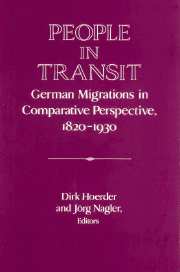Book contents
- Frontmatter
- Introduction
- PART I CONTINUITY AND COMPLEXITY: MIGRATIONS FROM EAST ELBIAN GERMANY AND GALICIAN POLAND
- Part II Internal German Migrations and In-Migrations
- PART III WOMEN'S MIGRATION: LABOR AND MARRIAGE MARKETS
- 10 The International Marriage Market: Theoretical and Historical Perspectives
- 11 Making Service Serve Themselves: Immigrant Women and Domestic Service in North America, 1850-1920
- 12 German Domestic Servants in America, 1850-1914: A New Look at German Immigrant Women's Experiences
- 13 Acculturation of Immigrant Women in Chicago at the Turn of the Twentieth Century
- PART IV ACCULTURATION IN AND RETURN FROM THE UNITED STATES
- 18 Migration Past and Present - The German Experience
- 19 Research on the German Migrations, 1820s to 1930s: A Report on the State of German Scholarship
- Index
10 - The International Marriage Market: Theoretical and Historical Perspectives
Published online by Cambridge University Press: 05 January 2013
- Frontmatter
- Introduction
- PART I CONTINUITY AND COMPLEXITY: MIGRATIONS FROM EAST ELBIAN GERMANY AND GALICIAN POLAND
- Part II Internal German Migrations and In-Migrations
- PART III WOMEN'S MIGRATION: LABOR AND MARRIAGE MARKETS
- 10 The International Marriage Market: Theoretical and Historical Perspectives
- 11 Making Service Serve Themselves: Immigrant Women and Domestic Service in North America, 1850-1920
- 12 German Domestic Servants in America, 1850-1914: A New Look at German Immigrant Women's Experiences
- 13 Acculturation of Immigrant Women in Chicago at the Turn of the Twentieth Century
- PART IV ACCULTURATION IN AND RETURN FROM THE UNITED STATES
- 18 Migration Past and Present - The German Experience
- 19 Research on the German Migrations, 1820s to 1930s: A Report on the State of German Scholarship
- Index
Summary
In 1860 Julius Lafontaine wrote to the mother of his prospective bride, asking her for her daughter's hand in marriage: “Oh Madam, times have changed. That which I strove for in Stuttgart without success, a good living, so that I could make your daughter happy, I have found here [in America]. I am still single. . . . I have worked up to the present with a special goal in mind. Now it is your choice, Madam, if your daughter still loves me, you can make two people happy.” We cannot know whether Lafontaine actually went to America primarily to earn money to marry, or whether this was simply a persuasive argument. The record shows that his plea worked, and Emma Lechler traveled from Stuttgart to San Francisco in order to marry him.
Marriage as a grounds for emigration may appear an exception to normal migration patterns. Yet an international marriage market is not the exception, nor is it confined to any particular period in history. By using examples from the United States immigrant population in the nineteenth and twentieth centuries, with special attention to German immigrants, I will describe this market and some of the many ways in which it operates.
Among German immigrants in the nineteenth century, marriage was a common theme in letters to the homeland. Both men and women wrote back to female friends and relatives about the generally good marital prospects in America, or about a certain individual a letter recipient could marry. Emigration manuals occasionally made claims along these lines: “Industrious and calm girls who are at least reasonably good looking can be sure that they will receive several proposals of marriage in the first year.” The statistics on German immigrant marriage patterns bore out the claim that young single female immigrants did not stay single long.
- Type
- Chapter
- Information
- People in TransitGerman Migrations in Comparative Perspective, 1820–1930, pp. 227 - 248Publisher: Cambridge University PressPrint publication year: 1995
- 3
- Cited by



